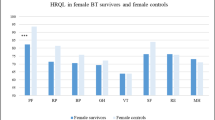Abstract
Central nervous system (CNS) tumours account for 20% of childhood cancers. Survivors often experience severe physical, neuropsychological and social sequelae of the disease and its treatment. Health status assessment in these individuals is an essential clinical outcome measure, yet little consensus exists regarding the optimum methodology. The influence of proxy respondents (parents, physiotherapists and doctors) and mode of administration (home and clinic) in which assessment is performed has been evaluated in a cohort of 37 survivors of childhood CNS tumours. A health-related quality of life (HRQOL) questionnaire, incorporating the Mark II and III Health Utilities Indices, was completed at home and in clinic by patients and parents. Doctors and physiotherapists completed this questionnaire plus Lansky Play-Performance and Karnofsky Performance scores. No significant differences between raters for single attribute scores occurred either at home or in clinic, although a wide range of agreement (κ =0.05-1.00, percentage agreement 53-100%) between observers was revealed. Most agreement occurred between parents and patients: this was greatest on home completion (%kappa; =0.48-1.00, percentage agreement 53-100%). Doctors and physiotherapists agreed less on subjective attributes (emotion, cognition and pain). Better agreement between all observers was demonstrated if responses were classified as normal or abnormal. Inter-observer agreement was greater for the HRQOL questionnaire than for Karnofsky and Lansky scores. Home completion of questionnaires provides a reliable, acceptable and convenient method of assessing health status.
Similar content being viewed by others
References
Stiller C, Bunch K. Brain and spinal tumours in children under 2 years: incidence and survival in Britain, 1975- 1985. Br J Cancer 1992; 66(Suppl 18): 550-553.
Lashford L, Campbell R, Gattamaneni HR, Robinson K, Walker D, Bailey C. An intensive multiagent chemotherapy regimen for brain tumours occurring in very young children. Arch Dis Child 1996; 74: 219-223.
Glaser A, Walker D. Quality of life. Lancet 1995; 346: 444.
Jenny MEM, Kane RL, Lune N. Developing a measure of health outcomes in survivors of childhood cancer: A review of the issues. Med Pediatric Oncol 1995; 24: 145-153.
. Clarridge BR, Massagli MP. The use of female spouse proxies in common symptom reporting. Med Care 1989; 27: 352.
Herjanic B, Reich W. Development of a structured psychiatric interview for children: agreement between child and parent on individual symptoms. J Abnormal Psychol 1982; 10: 307.
Ontario Ministry of Health. Ontario Health Survey, 1990, User's Guide. Vol. 1 : Documentation. Toronto, Canada: Ontario Ministry of Health. 1991.
Grootendorst P, Feeny D, Furlong W. Does it matter whom and how you ask? A technical report on inter-and intrarater agreement in the Ontario Health Survey. Centre for Health Economics and Policy Analysis Working Paper 94-12. Hamilton, Ontario: McMaster University, 1994.
Barr RD, Pai MR, Weitzman S, et al. A multi-attribute approach to health status measurement and clinical management - illustrated by an application to brain tumors in childhood. Int J Oncol 1994; 4: 639-648.
Kanabar DJ, Attard-Montalto S, Saha V, Kingston JE, Malpas JE, Eden OB. Quality of life in survivors of childhood cancer after megatherapy with autologous bone marrow rescue. Pediatric Hematol Oncol 1995; 12: 29-36.
Torrance GW, Furlong W, Feeny D, Boyle M. Multi attribute Preference - Health Utility Index. Pharmacoeconomics 1995; 7: 503-520.
Bilson A, Walker DA. Assessment of health status in survivors of cancer. Arch Dis Child 1994; 70: 200-204.
Lansky SB, List MA, Lansky LL, Ritter-Sterr C, Miller DR. The measurement of performance in childhood cancer patients. Cancer 1987; 60: 1651-1656.
Karnofsky DA, Burchenal JH. The clinical evaluation of chemotherapeutics in cancer. In: MacLoed CM, ed. Evaluation of chemotherapeutic agents.New York, NY: Columbia University Press, 1949: 191-205.
Torrance GW, Zhang Y, Feeny D. Multi-attribute Preference Functions for a Comprehensive Health Status Classification System. Hamilton, Ontario: McMaster University, Centre for Health Economics and Policy Analysis, 1992.
Boyle M, Furlong W, Feeny D, Torrance G, Hatcher J. Reliability of the Health Utilities Index-mark III used in Health status assessment in childrenthe 1991 cycle 6 Canadian General Social Survey Health Questionnaire. Qual Life Res 1995; 4: 249-257.
Cohen J. A co-efficient of agreement for nominal scales. Educational and Psychological Measurement 1960; 20: 37-46.
Altman D. Some common problems in medical research. In: Practical Statistics for Medical Research.London: Chapman and Hall, 1991: 396-439.
Landis RJ, Koch GG. The measurement of observer agreement for categorical data. Biometrics 1977; 33: 159-174.
Statistics Canada. General Social Survey: Health, 1991: Public Use Microdata File Documentation and User's Guide1992.
Goodwin DAJ, Boggs SR, Graham-Pole J. Development and validation of the pediatric oncology quality of life scale. Psychological Assessment 1994; 6: 321-328.
Magaziner J, Simonsick E, Kashner M, Hebel J. Patient-proxy response comparability on measures of patient health and functional status. J Clin Epidemiol 1988; 41: 1065-1074.
Stone WL, Lemanek KL. Developmental issues in children's self-reports. In: La Greca AM, ed. Through the Eyes of the Child: Obtaining Self-reports from Children and Adolescents. Boston: Allyn and Bacon, 18-56.
Author information
Authors and Affiliations
Rights and permissions
About this article
Cite this article
Glaser, A.W., Davies, K., Walker, D. et al. Influence of proxy respondents and mode of administration on health status assessment following central nervous system tumours in childhood. Qual Life Res 6, 43–53 (1997). https://doi.org/10.1023/A:1026465411669
Published:
Issue Date:
DOI: https://doi.org/10.1023/A:1026465411669




